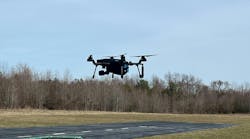A "crime camera" is essentially an integrated system providing video surveillance tools for law enforcement. The components of such a system include the camera itself, backend hardware and software, monitors, capture and storage devices and — most critical — network connectivity to securely and intelligently transport sensitive video data.
When a crime camera is available in the vicinity on an incident, police personnel can accelerate their response by gaining situational awareness within seconds. Instant awareness also translates into better-allocated resources, making sure, as they say, that officers aren't caught bringing a knife to a gunfight. When the stakes are high, only evidence-grade video over highly reliable networks can assure authorities that they'll have the information they need when trouble comes. Evidence-grade video, roughly defined as high-resolution video, is tamper-proof, stands up in court, increases convictions, assists in identification and helps prevent future crime.
Crime camera technologies have come a long way. Slowly the days of "unknown trouble" and vague 911 dispatch call reports are disappearing. What are the components of a crime camera system? How does one get started?
Snapshot: The system as a wholeAlthough crime camera systems require video technologies that produce high enough resolution for evidence-grade video, the camera itself is just one component of a larger system. "The cameras are only as good as the network that connects them," says Mark Jules, president of Maryland-based Avrio Group, which develops integrated wireless surveillance systems.
Assuming that a camera is connected to a network, what becomes important is the infrastructure that manages the movement and transmission of the significant amount of data the cameras collect. Because of innovations in performance and cost reductions, video surveillance networks are increasingly turning to wireless technologies to both support and supplant existing wired networks.
Let's Think Wireless LLC, a New Jersey-based systems integrator, has been in the municipal video surveillance market for more than eight years. "In the past, if a city wanted to install an IP video camera network, it would typically pay a telco or cable provider for the use of a leased circuit — provided the circuit was available in the desired location," says Craig Lerman, vice president and founder. "The costs ranged from $40 per month per camera for a cable modem, to a frame relay or shared T1 circuit (hundreds of dollars per month per camera). These public networks did not offer any quality of service mechanisms and the resulting video was of poor quality, with frequent outages on the network. Private fiber infrastructure, while providing excellent quality of transmission, is costly and time consuming to deploy. "
The advantages of wireless meshWireless mesh network-supported crime camera systems are rapidly becoming the go-to option for law enforcement. They offer key benefits lifting its advantages over its complexities.
- Flexibility. Where wired cameras must rely on the existence of wires, wireless crime cameras can be positioned almost anywhere to obtain the best point of view. There's no dependence on where the nearest network cable rests. This minimizes the need to drill holes, pull cable, trench ground, etc. Each of those activities is not only costly but also eats valuable time.
- Throughput. Crime cameras require an extensive amount of bandwidth to transmit data. Without enough bandwidth, cameras cannot deliver evidence-grade video or support video analytics: The better the video, the more effective analytic systems are at detecting shapes, movement and direction.
Not long ago, the demands of video required law enforcement agencies to use wires or costly microwave simply because they provided the necessary data throughput. Now, however, wireless network technologies can rival the results of wired networks. Los-Gatos, California-based Firetide, a developer of wireless mesh networking solutions, routinely delivers quality of wired Ethernet networks. Moreover, the flexibility, cost savings and other advantages alone are enough to justify exploring wireless mesh as a crime camera infrastructure, immediately. It certainly beats digging.
- Multi-hop or linear topology. Where fiber points-of-presence aren't readily available, video needs to be transmitted across wireless networks, with mesh offering critical resilience compared to point-to-point network setups. Unfortunately, in the majority of cases, video loses its fidelity to the point of being unusable after two or three hops (a hop is when data move from one network node to the next). Using a combination of high-power radios, load balancing, compression and other innovations, wireless mesh technology enable public safety agencies to flow video across 10 or more hops without significant loss of quality.
- Security and privacy of video streams. Secure systems offer what's known as "end-to-end encryption." Most mesh or access point systems need to decrypt feeds on intermediary nodes — nodes between the source and destination — to collect routing information that provides instructions about where to send video next. This can add unnecessary chattiness to the network, increasing problematic latency. To silence this, Firetide provides end-to-end encryption while eliminating performance-robbing redundant inspections along the way and also encapsulates packets traveling over secure links. Encapsulation provides an added level of security because only Firetide nodes can see the encapsulated packets.
- Multicasting. The idea behind multicasting is to compile information from one or more cameras and send it to multiple destinations for simultaneous viewing and recording. Multicasting is essential for remote monitoring by decision makers, but can severely burden a network. Firetide's encapsulation techniques, in addition to increasing security of data, enable multicasting of video streams across wireless networks — minimally impacting bandwidth.
A true infrastructure mesh should be able to handle all these capabilities. Firetide's networks function as a fully distributed, virtual Ethernet switch — distributing intelligence throughout the network to deliver self-healing and self-configuring capabilities.
Deploying successfullyDeploying a crime camera system requires the cooperation of diverse agencies. The details involved might initially sound overwhelming but delivering a positive experience and support from start to finish is the bread and butter of systems integrators such as Chicago-based Technology Consortium Group (TCG). As agencies move from one step to the next, TCG makes sure equipment is placed, tested and optimized according to plan, with necessary support upon completion.
"We run with the ball when our clients have a clear picture of what they want and where they want it," says TCG director of operations, mesh network products group, Ron Norris. "We work with multiple teams focused on implementing design, electrical, installation and connectivity." Norris adds that the primary goal is a solid system but also that his company focuses on "keeping everyone moving in sync" to help clients reduce costs.
Some specific steps any agency should expect when working with vendors and integrators as part of a crime camera system deployment lifecycle include:
Plan the network
Carpenters like to say, "Measure twice; cut once." The equivalent message for wireless network integrators might be "Site survey, site survey, site survey." Successful project plans will include site-specific details of the RF environment, the availability and location of fiber and power assets, bandwidth allocation, where networks are most likely to scale and more.
There's a strong administrative element to planning a wireless network too. Governance is extremely important. All stakeholders need to collaborate early and project managers should call together any anticipated detractors and pundits.
"Bringing everyone together as early as possible does more than help all parties feel they are part of the process," says Jules. "It also reduces the chances of an expensive mid-deployment work-stoppage or network redesign."
At this stage of the process, this is a good time to create any necessary procedural rules or schedules. How often will your cooperative agencies or departments meet? When and to whom will status reports be delivered? A communication plan minimizes frustrating speed bumps.
Deploying the gear and integrating the backend
When deploying a network, it's important not to underestimate how long it may take to obtain any necessary permits. Deployments must not unduly affect traffic flow, business activities, or other city functions.
With the network planned and camera and wireless network equipment mounted at predetermined locations, it's a priority to address how the camera pod will interact with the backend servers and software. Backend servers usually store video data, and contain the intelligence to perform analytics, help manage network load, provide user access policies and control cameras.
At a point in the process, someone within a law enforcement agency will determine the destination of feeds and how they are viewed using software such as Ocularis, developed by On-Net Surveillance Systems Inc. (OnSSI). Ocularis provides sophisticated software tools for camera control, video recording and managing and distributing multiple video surveillance feeds.
Manage network projects and performance
Managing a network project is the next critical element of success. The logistics start with the preliminary site survey and continue at an intense pace through final testing and approval. It's essential that people on the team have a grasp of all the pieces so they can be tuned and serviced as projects move forward.
According to Jules, "It's not enough to be a good RF engineer or enterprise systems manager. We require that each of our engineers responsible for a subsystem is aware of the impact they will have." He adds that any good project need be ready for rapid change. "Once they've gained comfort with an existing system, clients quickly discover new opportunities," he says. In other words, be prepared to scale.
Mitigating radio interference and optimizing links is an important part of managing any project. It costs money every time installers or inspectors need to evaluate equipment, the goal is to get it right the first time.
For quality control and task management, Norris makes great use of progress notes. "Issues logs, risk logs, change control logs, and other similar tools are important throughout the process," he advises. Along with a designated client team member, he documents and tracks all logs through final signoff.
(4) Scaling the network
When scaling-up a network to provide video surveillance that cover entire districts, or even cities, organizations should consider a number of common questions: Where is the demand for new cameras? What are the requirements for accessing mounting assets? Will new cameras, enclosures and network equipment meet a city's aesthetic requirements?
According to Lerman, there are logistical, topographical and even political challenges in creating a scalable city-wide wireless surveillance network. Key to successful implementation, while meeting cost and time constrains, include: the use of existing city-owned assets; creative public-private partnerships for the use of mounting assets not owned by the city; and using existing fiber infrastructure for transport.The project manager also needs to account for lengthy permitting process and right-of-way issues when dealing with utility companies.
Using an Ethernet-based approach, a wireless mesh network can scale to thousands of nodes by interconnecting meshes. Even very large mesh systems — networks of networks — can be managed using a single IP address if so desired.
When adding new surveillance coverage, wireless mesh networks can, and should, leverage existing fiber and Ethernet assets to offload video traffic to the wire. This aids in load-balancing and helps optimize how mesh networks use the available radio spectrum.
Even when existing fiber assets are available, the condition of the fiber, its conduits, and policies for accessing can hamper schedules, drive up costs and increase project risk. Wireless mesh can eliminate many of these obstacles, speeding implementation, testing and acceptance by end-users.
The cost savings of using wireless mesh over pulling new fiber, in areas where a fiber infrastructure is not available, is significant. Costs as high as $300 per linear foot are not uncommon for projects requiring trenching. If it costs $300 per linear foot to trench, at 20 feet that's $6,000. For similar cost, two mesh nodes will provide transport over several miles without ever touching a jack hammer or shovel.
Bo Larsson is CEO of Firetide. He can be reached at [email protected].


